Copyright 2014 by Michael Turback and Julia Hastings-Black All rights reserved. No part of this book may be reproduced in any manner without the express written consent of the publisher, except in the case of brief excerpts in critical reviews or articles. All inquiries should be addressed to Skyhorse Publishing, 307 West 36th Street, 11th Floor, New York, NY 10018. Skyhorse Publishing books may be purchased in bulk at special discounts for sales promotion, corporate gifts, fund-raising, or educational purposes. Special editions can also be created to specifications. For details, contact the Special Sales Department, Skyhorse Publishing, 307 West 36th Street, 11th Floor, New York, NY 10018 or .
Skyhorse and Skyhorse Publishing are registered trademarks of Skyhorse Publishing, Inc., a Delaware corporation. Visit our website at www.skyhorsepublishing.com. 10 9 8 7 6 5 4 3 2 1 Library of Congress Cataloging-in-Publication Data is available on file. Cover design by Owen Corrigan Print ISBN: 978-1-62914-523-5
Ebook ISBN: 978-1-62914-906-6 Printed in China 
 CONTENTS
CONTENTS 


 INTRODUCTION
INTRODUCTION  My rule of life prescribed the drinking of alcohol before, after, and if need be, during all meals and in the intervals between them. Winston Churchill
My rule of life prescribed the drinking of alcohol before, after, and if need be, during all meals and in the intervals between them. Winston Churchill  To state the obvious before getting into the curious, wine has long been the indispensable companion to fine dining. But curiously, as the profession of bartender becomes more like that of a chef, collaboration between bar and kitchen has progressed.
To state the obvious before getting into the curious, wine has long been the indispensable companion to fine dining. But curiously, as the profession of bartender becomes more like that of a chef, collaboration between bar and kitchen has progressed.
The marriage of food and wine should allow for infidelity, suggested culinary writer Roy Andries de Groot. Ingredient-driven cocktails, made with top-shelf liquors, fresh seasonal fruits, flavored bitters, and other artisanal components, have begun to reflect a restaurants artful cuisine and to challenge wines dominance as the dinner beverage of choice. The secret is outour food is having an affair with cocktails. The mutual attraction of cocktails and food was noticed as early as 1933 in the book Whatll You Have? by Julien J. Proskauer: The perfect hostess never serves cocktails without some little appetizer accompanying them. This book explores cocktail pairings beyond the traditional accompaniments.
Forty-four original pairings, including appetizers, soups, salads, entres, and desserts were collected from restaurants around the United States. First-rate food and mixed drinksjudiciously and harmoniously pairedbecome something more than the sum of their parts. Cocktails at Dinner serves as a primer to these progressive combinations for the home kitchen and bar, for cooks and bartenders at all levels. It showcases a range of innovative, yet accessible recipes from a diversity of cuisines, opening the door to new possibilities in dining and entertaining. This compendium is a coming out of sorts for a restless band of artisans who have in common the desire to deliver something more and the willingness for open exchange. An idea may originate in the kitchen and then work its way out to the bar.
Or a bartenders novel concoction might provide inspiration for a new dish by the chef. Parisian bartender Colin Peter Field suggests that, like great sauce chefs, bartenders must be experienced and thoughtful as far as their ingredients are concerned. The joint efforts of chefs and bartenders featured here provide unexpected pleasures and stretch palate perspectives. The process or methodology by which each pairing came together is explained, leading the reader on a sensorial journey to new and interesting partnerships at the table. Cocktails can lend a more festive atmosphere to special occasions, and playing matchmaker with food and drink could liven up the menu at your next get-together. Successful pairings require familiarity with the flavors and aromas of spirits and liqueurs, as well as an understanding of food preparations, ingredients, and the ways different flavors harmonize and connect.
For you, dear reader, we offer a books worth of examples and guidance. With this volume as trusted accomplice, youll be able to recreate a variety of enlightened pairings with precision and confidence. 
 PAIRING PRINCIPLES
PAIRING PRINCIPLES 
 Like jazz, a successful pairing cant always be explained in specifics, but you know it when you taste it. The flavors and textures of a well-paired dish and drink will play off of each other in surprising and pleasing ways. Sometimes a cocktail works so well with a dish, you cant imagine one without the other. When experimenting with new pairings, begin by tasting each in your mind.
Like jazz, a successful pairing cant always be explained in specifics, but you know it when you taste it. The flavors and textures of a well-paired dish and drink will play off of each other in surprising and pleasing ways. Sometimes a cocktail works so well with a dish, you cant imagine one without the other. When experimenting with new pairings, begin by tasting each in your mind.
If food drives the cocktail, consider the dishs flavor profiles and then fashion a complementary drink. If a cocktail inspires a counterpart from the kitchen, find a proper balance, with neither food nor drink dominating the other. The Italian sartorial art of contrasting jackets and trousers is called spezzato , a term we have appropriated from menswear to describe a food/cocktail pairing gone wrong. The benefits of experimentation are undeniable, yet one should avoid a spezzato at the dinner table like a mismatched top and bottom. The following principles are intended to inspire and guide your own successful matchmaking: Buy fresh, high-quality ingredients for both dish and cocktail. Professional mixologists build their drinks from the same pool of ingredients used by the chef.
A cocktail pairs well with a dish by one of two meansmatching or contrasting its flavors. For example, the smoky, woody flavor of a bourbon-based drink heightens similar flavors in barbequed meat. On the flipside, a cocktail can temper extreme flavorsfor example, a sweet or fruit-driven drink can bring a cool contrast to a spicy dish. Complement a dish by using a common ingredient (or ingredients) in the cocktail recipe. Herbs can be used in this capacity, either muddled or added as garnish for their aroma and visual appeal. If a cocktails predominant flavors come from the mixers, rather than the spirits, use those to guide the pairing.
For instance, the lemon in a margarita instead of the tequila might better define a partnership with a seafood dish. For a dish with complicated flavors or multiple seasonings, serve a cocktail thats simple and distinct. Dont overpower the dish. Avoid pairing a high-alcohol cocktail with a dish that has especially subtle flavors. On the other hand, dishes with strong flavors such as fried foods or those containing cheese or smoked fish, can stand up to the taste of alcohol. Consider the texture or consistency of a cocktail.

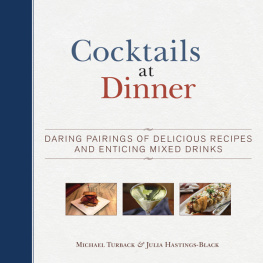
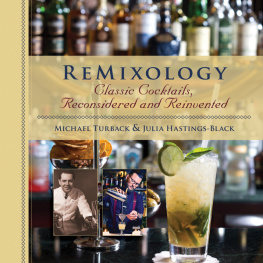
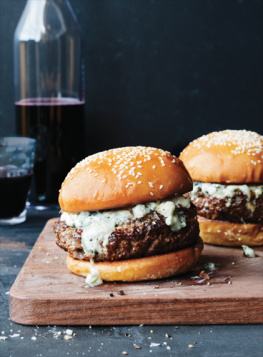
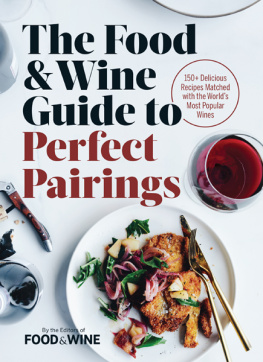

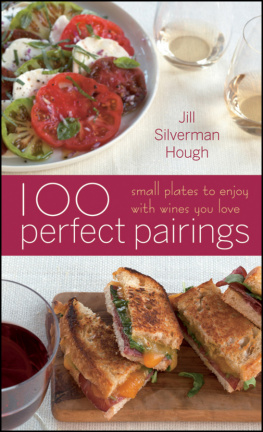
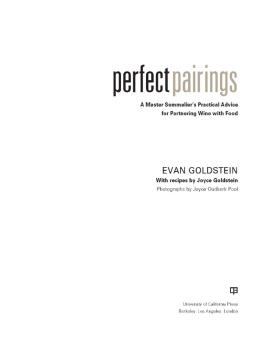


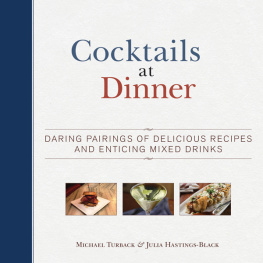


 CONTENTS
CONTENTS 


 INTRODUCTION
INTRODUCTION  My rule of life prescribed the drinking of alcohol before, after, and if need be, during all meals and in the intervals between them. Winston Churchill
My rule of life prescribed the drinking of alcohol before, after, and if need be, during all meals and in the intervals between them. Winston Churchill  To state the obvious before getting into the curious, wine has long been the indispensable companion to fine dining. But curiously, as the profession of bartender becomes more like that of a chef, collaboration between bar and kitchen has progressed.
To state the obvious before getting into the curious, wine has long been the indispensable companion to fine dining. But curiously, as the profession of bartender becomes more like that of a chef, collaboration between bar and kitchen has progressed.